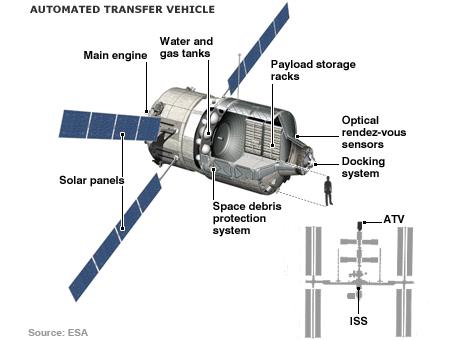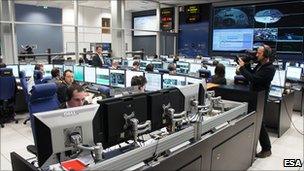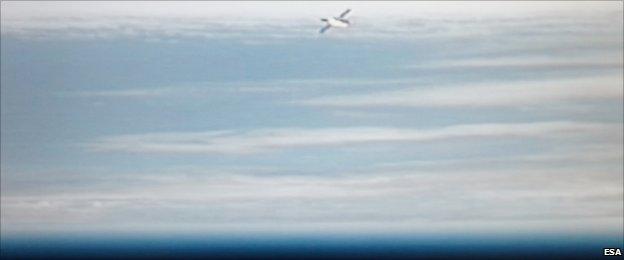Johannes Kepler freighter docks with space station
- Published
Esa's Johannes Kepler cargo vehicle docks with the ISS
Europe's sophisticated space freighter, Johannes Kepler, external, has docked with the International Space Station (ISS).
The unmanned robotic truck attached itself to the Zvezda module on the rear of the platform at 1559 GMT.
The ship is delivering new supplies of fuel, food, air, and equipment to the ISS's astronauts.
Kepler is totally automatic and used its own computerised systems and sensors to find the station in orbit and make the connection.
Having travelled half a million kilometres since its launch eight days ago, the freighter made the docking with an accuracy that could be measured in centimetres.
Confirmation that the seal between the freighter and Zvezda was fully satisfactory came at 1608 GMT.
"It went as smooth as we could have dreamed it would," European Space Agency Director-General Jean-Jacques Dordain told BBC News.
The 20-tonne ship's mission managers, based in Toulouse, France, oversaw the final automated manoeuvres but had no need to intervene.
Italian astronaut Paolo Nespoli and Russian cosmonaut Aleksandr Kaleri were inside Zvezda when Kepler made its final approach.
They will need to scrub the air inside the ship before entering.
The docking permits the US shuttle Discovery to launch from Florida later in the day. It has a date with the ISS, too, and will be carrying up six visiting astronauts and a smart humanoid robot.

The truck - also known by its generic name of Automated Transfer Vehicle (ATV) - is the second such ship launched to the ISS by the European Space Agency.
The first, nicknamed Jules Verne, completed its mission in 2008.

Mission control for the freighter is in Toulouse in southern France
One of the freighter's main tasks in the coming months will be to raise the altitude of the station, which is currently at about 350km.
The ISS has a tendency to fall back to Earth over time as it drags through the top of the atmosphere.
Every few weeks the freighter will fire its thrusters to accelerate the platform, taking it higher into the sky.
The freighter will be used like a store cupboard by the ISS astronauts.
They will go into the pressurised vessel to obtain food, clothing and equipment when they need it. Additional fuel will be piped across to the main station complex; air will simply be vented from taps.
As Kepler's supplies are depleted, the void will be filled with rubbish. The vehicle will take this waste into a controlled burn-up over the Pacific Ocean when it leaves the station sometime from June onwards.
Industrial capability
The freighters are a kind of subscription that Europe has to pay to be a member of the International Space Station "club". Instead of handing over cash to the Americans to get access to the orbiting laboratory for its astronauts, Europe has instead bartered a logistics role for itself.
So long as ATVs keep turning up at the station with several tonnes of food, water, air, fuel and equipment, European astronauts can claim a place on the platform for six months out of every 24.
The supplies that fly on Kepler and the next three ATVs should see Europe meet its end of the bargain through to about 2016. But the station is set to fly until at least 2020, and Europe is negotiating with the US space agency how it should pay its subscription in future.
This is likely to lead to an evolved ATV, one that keeps its core rendezvous and docking technologies but is updated to fulfil new tasks.
"We have to meet our obligations and just how we do this is subject to negotiation with Nasa," said Mr Dordain.
"If we move to a new vehicle, what I have said to Nasa is, one, that this vehicle uses the industrial capability developed for ATV and Columbus (the ISS laboratory) because the objective is not to create new industrial capability and destroy the capability that already exists. Two, this vehicle should also be useful for space station exploitation; and, three, this vehicle should be useful beyond the space station for future exploration."
Mr Dordain also told BBC News that he expected Esa member states to put in place formal arrangements to support ISS exploitation to 2020 at the agency's March Council meeting.

Johannes Kepler is seen from the ISS. Step by step, the vehicle brought itself up to the platform
- Published17 February 2011
- Published29 September 2010